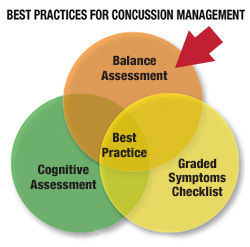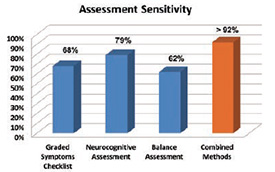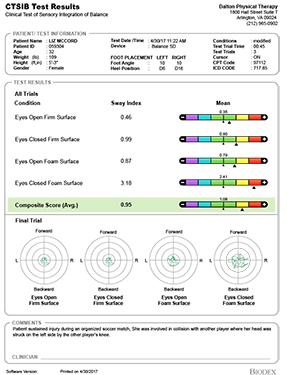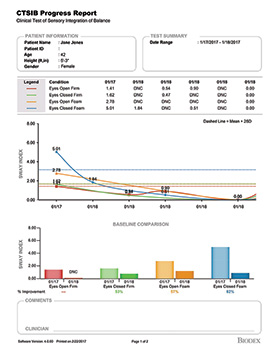- Physical Medicine Home
- Products
- Programs
- Applications
- Find a Clinic
- Blog
- Events
- Education & Training
- In The News
- Press Releases
Biodex Balance Assessment for Concussion Management
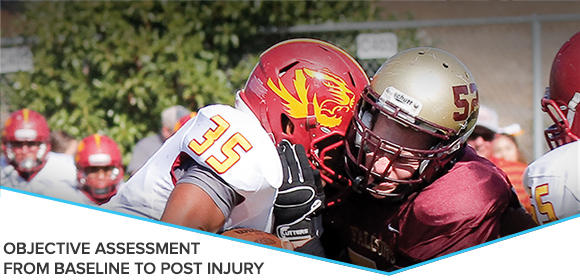
| Overview | Balance Assessment | Elements | Documentation | Marketing Support | Models and Ordering |
Overview
Objective Assessment from Baseline to Post Injury
 |
Combined Assessment
Biodex Balance Assessment adds the objective, neurophysical component for the management of concussion. The benefit is that clinicians are able to quantify the elements of balance - before and after an injury occurs.
Detailed summary and progress reports track recovery and provide the medical team with quantitative data to help with the return-to-play decision.
Biodex Balance Technology
Biodex Balance Assessment is conducted using either the versatile Balance System™ SD or portable BioSway™ device. The Biodex Balance System SD is a sophisticated measuring and training device for static and dynamic balance testing and training. The BioSway device is portable with a static-only platform.
The mCTSIB can be performed on either Biodex balance device, designed to systematically test the sensory selection process by compromising available somatosensory, visual, and vestibular senses while measuring an athlete’s ability to minimize postural sway. The Sway Index is an objective quantification of postural sway and is measured during the mCTSIB. The test provides a generalized assessment of how well an athlete can integrate various senses with respect to balance, and compensate when one or more of those senses are compromised. A higher Sway Index indicates a reduction in the athlete’s ability to remain steady during the test.
In addition to performing the CTSIB test, the Balance System SD and BioSway software includes the option of conducting a modified version of a Balance Error Scoring System (BESS) test of postural stability, popular for concussion management. Both systems now feature the ability to create custom sensory integration balance testing which allows for modification of existing or the creation of entirely new protocols with both the CTSIB and BESS tests.4 Both systems feature the ability to perform a modified version of the Clinical Test of Sensory Integration of Balance (CTSIB) for postural stability, popular for concussion management. Modify existing CTSIB and BESS test parameters or create custom sensory integration protocols.4
Clinical Test of Sensory Integration of Balance (CTSIB)
The Biodex mCTSIB quantifies postural sway under these four sensory conditions
| Eyes Open, Firm Surface |
Information available by all three sensory inputs: Somatosensory, visual and vestibular. |
| Eyes Closed, Firm Surface |
Visual not available; somatosensory and vestibular are available. If the athlete performs poorly, the vestibular or somatosensory may be compromised, with an increase in visual dependency. |
| Eyes Open, Unstable Surface |
Somatosensory compromised; visual and vestibular are available. If the athlete performed poorly, visual or vestibular may be compromised, with an increase in somatosensory dependency. |
| Eyes Closed, Unstable Surface |
Visual not available; somatosensory compromised, only vestibular available. Concussed athletes are most likely to present problems in this condition. If performance is reduced beyond normal or baseline readings, the vestibular system may be disrupted. |
References
| 1 | Guskiewicz, KM, et al, Postural Stability and Neuropsychological Deficits After Concussion in Collegiate Athletes (Journal of Athletic Training 2001;36(3):263–273 |
| 2 | Valovich McLeod T, The Value of Various Assessment Techniques in Detecting the Effects of Concussion on Cognition, Symptoms, and Postural Control. Journal of Athletic Training 2009;44(6):663–665 |
| 3 | Broglio SP, Macciocchi SN, Ferrara MS. Sensitivity of the concussion assessment battery. Neurosurgery. 2007;60:1050-1057; discussion 1057-1058. |
| 4 | Finnoff, JT, et al (2009). Intrarater and Interrater Reliability of the Balance Error Scoring System (BESS). PM&R, Volume 1, Issue 1, January 2009 |
| 5 | McCrory P, Meeuwisse W, Johnston K, Dvorak J, Aubry M, Molloy M, et al. Consensus statement on concussion in sport the 3rd International Conference on concussion in sport, held in Zurich, November 2008. J Clin Neurosci. 2009;16:755–63. |
| 6 | Guskiewicz, KM, et al (2004). National Athletic Trainers’ Association Position Statement: Management of Sport-Related Concussion Journal of Athletic Training 2004;39(3):280–297 |
Balance Assessment
Measuring Balance In fact, research has shown that balance assessment, in combination with cognitive testing and a graded symptoms checklist, increases overall sensitivity to greater than 90%.3 |
| “Formal cognitive and postural-stability testing is recommended to assist in determining injury severity and readiness to return to play (RTP).” 6 – NATA® Position Statement on Sport-related Concussion |
Measuring Postural Sway
Postural stability testing is an accepted objective measure in the evaluation of athletes with acute cerebral concussion. Large negative effects in postural sway are often identified at both immediate and follow-up assessment points, demonstrating the need for assessment of postural control as part of a concussion protocol. Biodex Balance Assessment goes beyond objective balance testing for changes in postural sway. Using the Clinical Test of Sensory Integration of Balance (CTSIB), independent testing of all three sensory feedback systems can determine the individual's reliance on the visual, vestibular and somatosensory systems.
Clinical Test of Sensory Integration of Balance
The Clinical Test of Sensory Integration of Balance (CTSIB) is the accepted, standardized assessment that identifies and tracks disturbances in balance and the three associated sensory systems. Combined with today’s technological advances, this test provides the sports medicine community with a more accurate and objective assessment tool for evaluating postural stability.
References
| 1 | Guskiewicz, KM, et al, Postural Stability and Neuropsychological Deficits After Concussion in Collegiate Athletes (Journal of Athletic Training 2001;36(3):263–273 |
| 2 | Valovich McLeod T, The Value of Various Assessment Techniques in Detecting the Effects of Concussion on Cognition, Symptoms, and Postural Control. Journal of Athletic Training 2009;44(6):663–665 |
| 3 | Broglio SP, Macciocchi SN, Ferrara MS. Sensitivity of the concussion assessment battery. Neurosurgery. 2007;60:1050-1057; discussion 1057-1058. |
| 4 | Finnoff, JT, et al (2009). Intrarater and Interrater Reliability of the Balance Error Scoring System (BESS). PM&R, Volume 1, Issue 1, January 2009 |
| 5 | McCrory P, Meeuwisse W, Johnston K, Dvorak J, Aubry M, Molloy M, et al. Consensus statement on concussion in sport the 3rd International Conference on concussion in sport, held in Zurich, November 2008. J Clin Neurosci. 2009;16:755–63. |
| 6 | Guskiewicz, KM, et al (2004). National Athletic Trainers’ Association Position Statement: Management of Sport-Related Concussion Journal of Athletic Training 2004;39(3):280–297 |
Elements
Elements of the Biodex Balance Assessment Program
- Objective Balance Assessment
Both the Biodex Balance System SD and the portable BioSway deliver objective preseason baseline and post-injury balance assessment and provide extensive reporting capabilities for post-injury comparison.
These devices provide the Clinical Test of Sensory Integration of Balance (mCTSIB) and the Balance Error Scoring System (BESS) test for postural stability, both suitable for concussion. The mCTSIB and BESS tests can be customized to suit your facility’s needs..
Both products not only provide a balance assessment program for concussion management, but also offer multiple rehabilitation training protocols that can be used across a broad scope of athletic populations for general orthopedic and neuromuscular rehabilitation and athletic conditioning.
- NEW Extensive Normative Data
Test results from a healthy population of student-athletes are stored on the system for general normative data comparison. - Summary & Progress Reports
Show status, progress and outcomes of balance tests. These reports can be forwarded to doctors, coaches, parents, or athletes to provide quantitative data that substantiates return-to-play decisions.
Marketing Support
- Biodex provides an assortment of customizable marketing support materials that you can use to educate Physicians, Athletic Directors, Parents and Athletes on the importance of Baseline and Post-Injury Balance Assessment.
Documentation
| The objective measure from postural stability/balance testing provides clinicians with an important additional piece of the concussion puzzle and assists them in determining readiness for return to play. 1 |
Objective Documentation
Data from objective measures of postural stability is a critical component in determining severity of injury and post-injury recovery. Both the Biodex Balance System SD and portable BioSway provide postural stability/balance testing with objective documentation including detailed baseline and post-injury summary reports and progress reports with comparison to normative data. Reports are used to track recovery and can be forwarded to doctors, coaches, parents or athletes to provide quantitative data that substantiates return-to-play decisions.
Normative databases are available targeting athletic population for a leading edge with balance assessment for concussion management.
Follow an athlete's progress from baseline testing through post-injury evaluation.
DISCLAIMER: The information provided is not intended to be a substitute for professional medical advice but as a guideline to assessing athletes following a concussion. Always seek the care of a physician or other qualified healthcare provider with any questions or concerns you may have about a medical condition. If there is any question/concern about the athlete's status then recommend not returning to play.
Marketing Support
Concussion Management –
Make it Your Business!
Available exclusively to our customers using Balance Assessment in support of a concussion management program, Biodex provides an assortment of marketing materials to attract athletes, parents, community sports teams, school coaches and athletic directors, as well as referring pediatricians. Materials can be customized to reflect your facility and used to broadcast the role of Balance Assessment in the management of concussion.
Materials include:
- Sample Letters to coaches and athletic directors, pediatricians or referring physicians and to the parents of local team athletes.
- Sample Press Release for local newspapers.
- Tri-Fold Brochure, customizable with your facility contact information, to use as follow up to the letters, placed in the waiting room, or sent to anyone that would benefit by learning about your program.
- Clinical Voucher, customizable with your facility contact information, to send to partnering physicians directing athletes to your facility for baseline testing.
- Concussion Posters to display in your own facility or with partnering physicians, alerting patients to your Balance Assessment Program.
Models and Ordering
To order, call 1-800-224-6339
Balance System SD
| 950-440 | Balance System SD, Includes Indexed CTSIB Pad, Printer and Printer Stand. |
Optional:
| 950-430 | VibroTactile™ System Includes transmitter, two tactile belts (S/M and L/XL), each with wireless receiver and connection cables. |
| 950-450 | FreeSway™ Handles Fits latest model Balance System SD with adjustable-height handles only. |
| 950-306 | Step Stool |
Resources Included:
- eLearning Tutorials for increased product utilization.
- Marketing Support for Balance Assessment for Concussion Management.
BioSway
| 950-460 |
BioSway 15.6" LCD with Tabletop Stand and Case, 115V/230V 50/60Hz Includes: Instrumented platform, CTSIB Indexed Pad, 15.6" color display with tabletop stand/wall mount bracket, AC adapter for 100-240 V input, and two blindfolds. |
Optional:
| 950-465 | Adjustable Height Stand for 15.6" Display |
| 950-464 | HP Office Jet Printer (compact portable printer) |
| 950-467 | HP InkJet Printer |
| 950-466 | Printer Stand |
Resources Included:
- eLearning Tutorials for increased product utilization.
- Marketing Support for Balance Assessment for Concussion Management.
|
Request More Information
Conditions of Purchase

Primary Resources
What They Are Saying
St. Edward's University
Head Athletic Trainer
Lisa Lowe MEd, ATC, LAT, CSCS
“We are extremely excited about getting started with our Biodex Concussion Varsity Program here at St. Edward's University in Austin, TX.”
... read more >
In The News
Older drivers with history of falling have higher crash risks
... read more >

